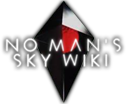| The subject of this article is from the Living Ship update.
The information from this article is up-to-date as of 6 April, 2020. |
The information from this article is is up-to-date as of 6 April, 2020.
| This article was documented by the Galactic Hub. |

A subproject of the Galactic Hub Project.
Summary[ | ]
Subproject 2: Nimbus - Weather Research, or just Subproject Nimbus, is the second official Subproject of the Galactic Hub Project. Initially launched in May 2017, the subproject was rebooted in April 2020.
Purpose[ | ]
The purpose of Subproject Nimbus is to understand the effects of weather in No Man's Sky.
Initially, it may seem that the game itself tells us all we need to know about weather. However, a greater understanding of weather in NMS may help with the creation of a No Man's Sky weather app. Perhaps not necessary or particularly useful, but still an interesting pursuit for some Interlopers.
Regarding the sections which refer to "Time of Day" or "the clock": using the dedicated Photo Mode or the time in the Analysis Visor, travelers are able to check the local time on a planet. Just enter Photo Mode, and then the first category in the "Scene" tab will be "Time of Day." Note that this is sometimes buggy. You may need to "Restore Defaults" and then enter and exit Photo Mode to get an accurate reading, particularly if you've moved the sun around. For this reason, checking the time in your Analysis Visor may be a better option.
Specific Goals[ | ]
Measure Hourly Weather, Toxicity, Radiation, & Water Temperature[ | ]
All weather data is recorded in a spreadsheet, which will later be made available to the public and turned into graphs. Contact 7101334 for editing permission.
All measurements must be in Celsius! Because all measurements are assumed to be in Celsius, you do not need to put degrees Celsius or °C after each measurement.
- Hourly recordings demonstrate trends in temperature (in the air and in the water), toxicity, and radioactivity levels.
- Hourly recordings may help with the creation of a planetary weather apps.
- For toxic planets, switch "temperature" with "toxicity" as appropriate. For radioactive planets, switch "temperature" with "radioactivity" as appropriate.
For the purpose of this research, planets are divided into the following classes, based on the in-game Biomes:
- Dead - Barren planet with no flora or fauna besides occasional resource plants.
- Lush - Planets with Star Bulb.
- Cold - Planets with Coryzagen.
- Hot - Planets with Fervidium.
- Desert - Planets with Spadonium.
- Toxic - Planets with Temerium.
- Irradiated - Planets with Candensium.
- Exotic - "Shard," "Jack," "Bubble," and similar planets added with Update 1.30 / Atlas Rises. Never any fauna on these planets.
- Megaflora - Similar to certain other biomes, such as Lush, Hot, or Toxic, but with extremely large plants. Record these as "Megaflora (Subtype)", ie "Megaflora (Toxic)" for huge mushrooms.
- Megalith - Planets defined by giant, abnormal geological features, such as huge rings or spikes. Note these as "Megalith (Spike)," "Megalith (Ring)".
Measure Exosuit Shield System Limitations[ | ]
It would be useful to know the exact temperatures when your exosuit shields activate. It's currently unknown if it's constant between all planets, or if different biomes (or even weather types) all affect the exact temperature that your shields activate. Additionally, these would be useful markers on graphs of the previous goal's results (hourly weather).
Measure Water Temperature[ | ]
This one is pretty self explanatory - measuring the temperature of bodies of water, and possible related factors (highest planet temp, lowest planet temp, planet type, planet weather). Jump in, wait for your exosuit temperature to remain constant, and take a reading. Note that water temperature does vary throughout the day on a cycle, just like air temperature, although the change seems to generally be much smaller.
Results[ | ]
Measure Hourly Weather, Toxicity, Radiation, & Water Temperature[ | ]
- Storm conditions are always the same for a given planet, so it doesn't matter what time of day you record those conditions. Just make sure your exosuit meter is completely finished increasing or decreasing its temperature, RAD, & TOX readings before recording. Do not record storm conditions in the regular temperature/TOX/RAD fields.
- Storm conditions do not appear to effect water temperature conditions, even though the number will flash red.
- Temperatures are constant everywhere on a planet (relative to the time), so if you miss some values due to a storm, you can just fly to a darker or lighter part of the planet and wait.
- For planets without any storms, just put "N/A" (not applicable) for that field.
Ask 7101334 for access to the spreadsheet to add your results and view the results of others. Eventually, they will be turned into graphs and shared publicly.
Measure Exosuit Shield System Limitations[ | ]
What temperature, radioactivity (RAD), or toxicity (TOX) level did your shield activate at? How many "arrows"? What type of planet?
Thermic Layer (Cold Shield)[ | ]
| Planet Type (Hot, Cold, etc) | Weather | Highest Temp. | Lowest Temp. | Shield Activation Temp. | # of Arrows |
|---|---|---|---|---|---|
Coolant Network (Heat Shield)[ | ]
| Planet Type (Hot, Cold, etc) | Weather | Highest Temp. | Lowest Temp. | Shield Activation Temp. | # of Arrows |
|---|---|---|---|---|---|
Radiation Deflector (Radioactivity Shield)[ | ]
NOTE: Although radiation levels are displayed on various planets, only radioactive planets will activate your radiation shields at this time. As such, it is not necessary to record Planet Type for this chart.
| Weather | Highest RAD | Lowest RAD | Shield Activation RAD | # of Arrows |
|---|---|---|---|---|
Toxin Suppressor (Toxicity Shield)[ | ]
NOTE: Although radiation levels are displayed on various planets, only toxic planets will activate your radiation shields as of Living Ship update. As such, it is not necessary to record Planet Type for this chart.
| Weather | Highest TOX | Lowest TOX | Shield Activation TOX | # of Arrows |
|---|---|---|---|---|
Pre-Update 1.30 Results[ | ]
Measure Hourly Weather[ | ]
Measure Exosuit Shield System Limitations[ | ]
What temperature did it activate at? How many "arrows"? What type of planet?
Thermic Layer (Cold Shield)[ | ]
| Planet Type (Hot, Cold, etc) | Weather | Highest Temp. | Lowest Temp. | Shield Activation Temp. | # of Arrows |
|---|---|---|---|---|---|
| Desert | Baked | 30.0 | -21.6 | -25.1 | 1 |
Coolant Network (Heat Shield)[ | ]
| Planet Type (Hot, Cold, etc) | Weather | Highest Temp. | Lowest Temp. | Shield Activation Temp. | # of Arrows |
|---|---|---|---|---|---|
| Desert | Baked | 30.0 | -21.6 | 75.6 | 3 |
Measure Water Temperature[ | ]
| Planet Type (Hot, Cold, etc) | Weather | Highest Temp. | Lowest Temp. | Water Temp. |
|---|---|---|---|---|
| Lush | Mild | 2.4 | -3.9 | 7.0 |
Additional Notes[ | ]
- "Desert, Baked" planet reached maximum daytime temperature without activating Coolant Network (Heat Shields). Heat Shields only activated on this planet during storms.

